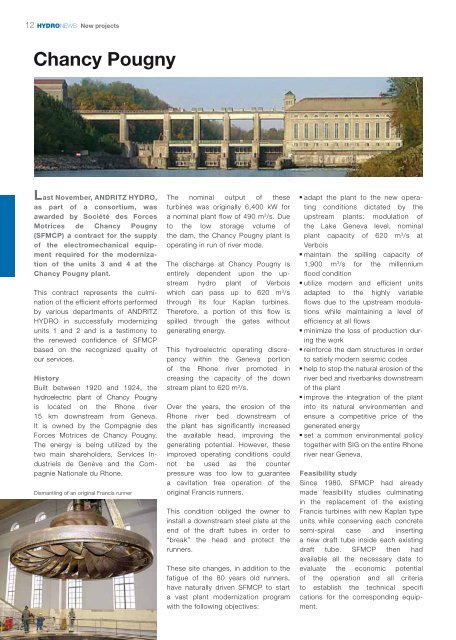Guri II - ANDRITZ
Guri II - ANDRITZ
Guri II - ANDRITZ
Create successful ePaper yourself
Turn your PDF publications into a flip-book with our unique Google optimized e-Paper software.
12 HYDRONEWS New projects<br />
Chancy Pougny<br />
Last November, <strong>ANDRITZ</strong> HYDRO,<br />
as part of a consortium, was<br />
awarded by Société des Forces<br />
Motrices de Chancy Pougny<br />
(SFMCP) a contract for the supply<br />
of the electromechanical equipment<br />
required for the modernization<br />
of the units 3 and 4 at the<br />
Chancy Pougny plant.<br />
This contract represents the culmination<br />
of the efficient efforts performed<br />
by various departments of <strong>ANDRITZ</strong><br />
HYDRO in successfully modernizing<br />
units 1 and 2 and is a testimony to<br />
the renewed confidence of SFMCP<br />
based on the recognized quality of<br />
our services.<br />
History<br />
Built between 1920 and 1924, the<br />
hydroelectric plant of Chancy Pougny<br />
is located on the Rhone river<br />
15 km downstream from Geneva.<br />
It is owned by the Compagnie des<br />
Forces Motrices de Chancy Pougny.<br />
The energy is being utilized by the<br />
two main shareholders, Services Industriels<br />
de Genève and the Compagnie<br />
Nationale du Rhone.<br />
Dismantling of an original Francis runner<br />
The nominal output of these<br />
turbines was originally 6,400 kW for<br />
a nominal plant flow of 490 m 3 /s. Due<br />
to the low storage volume of<br />
the dam, the Chancy Pougny plant is<br />
operating in run of river mode.<br />
The discharge at Chancy Pougny is<br />
entirely dependent upon the upstream<br />
hydro plant of Verbois<br />
which can pass up to 620 m 3 /s<br />
through its four Kaplan turbines.<br />
Therefore, a portion of this flow is<br />
spilled through the gates without<br />
generating energy.<br />
This hydroelectric operating discrepancy<br />
within the Geneva portion<br />
of the Rhone river promoted in<br />
creasing the capacity of the down<br />
stream plant to 620 m 3 /s.<br />
Over the years, the erosion of the<br />
Rhone river bed downstream of<br />
the plant has significantly increased<br />
the available head, improving the<br />
generating potential. However, these<br />
improved operating conditions could<br />
not be used as the counter<br />
pressure was too low to guarantee<br />
a cavitation free operation of the<br />
original Francis runners.<br />
This condition obliged the owner to<br />
install a downstream steel plate at the<br />
end of the draft tubes in order to<br />
“break” the head and protect the<br />
runners.<br />
These site changes, in addition to the<br />
fatigue of the 80 years old runners,<br />
have naturally driven SFMCP to start<br />
a vast plant modernization program<br />
with the following objectives:<br />
■<br />
adapt the plant to the new operating<br />
conditions dictated by the<br />
upstream plants: modulation of<br />
the Lake Geneva level, nominal<br />
plant capacity of 620 m 3 /s at<br />
Verbois<br />
■<br />
maintain the spilling capacity of<br />
1,900 m 3 /s for the millennium<br />
flood condition<br />
■<br />
utilize modern and efficient units<br />
adapted to the highly variable<br />
flows due to the upstream modulations<br />
while maintaining a level of<br />
efficiency at all flows<br />
■<br />
minimize the loss of production during<br />
the work<br />
■<br />
reinforce the dam structures in order<br />
to satisfy modern seismic codes<br />
■<br />
help to stop the natural erosion of the<br />
river bed and riverbanks downstream<br />
of the plant<br />
■<br />
improve the integration of the plant<br />
into its natural environmenten and<br />
ensure a competitive price of the<br />
generated energy<br />
■<br />
set a common environmental policy<br />
together with SIG on the entire Rhone<br />
river near Geneva.<br />
Feasibility study<br />
Since 1980, SFMCP had already<br />
made feasibility studies culminating<br />
in the replacement of the existing<br />
Francis turbines with new Kaplan type<br />
units while conserving each concrete<br />
semi-spiral case and inserting<br />
a new draft tube inside each existing<br />
draft tube. SFMCP then had<br />
available all the necessary data to<br />
evaluate the economic potential<br />
of the operation and all criteria<br />
to establish the technical specifi<br />
cations for the corresponding equipment.


